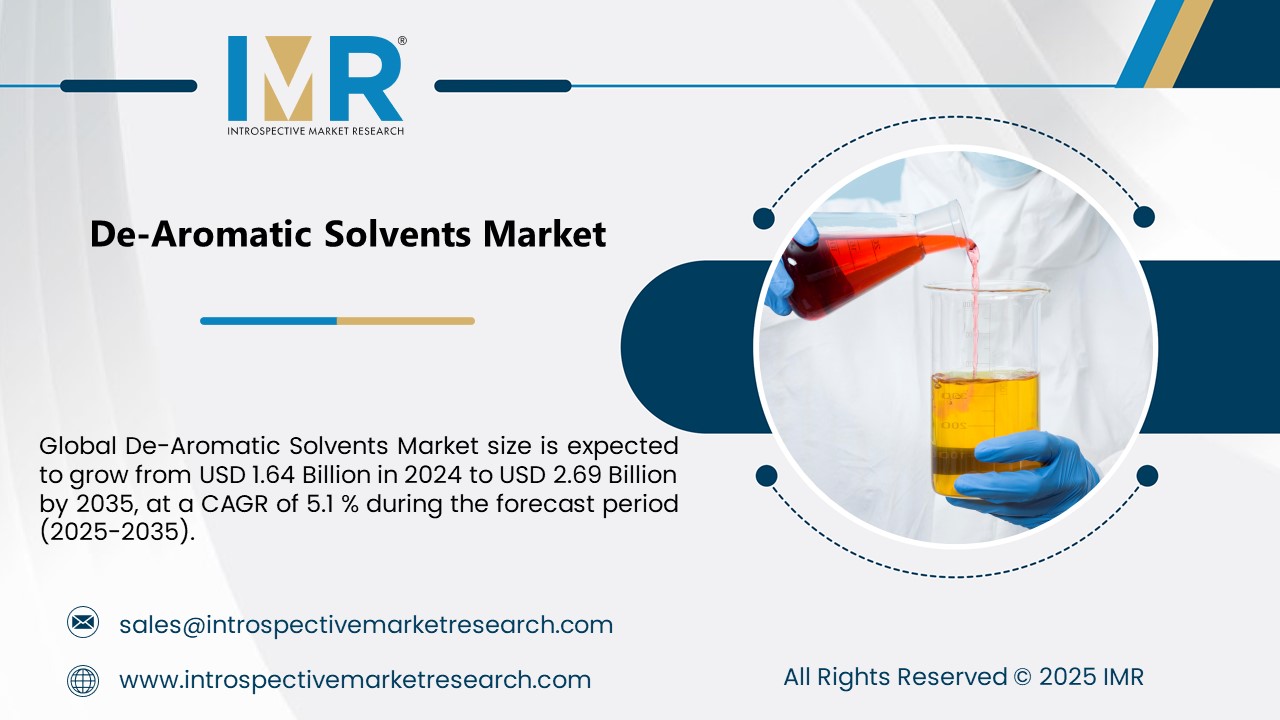According to a new report published by Introspective Market Research, titled, De-Aromatic Solvents Market by Application, Flash Point, Boiling Point. Opportunity Analysis and Industry Forecast, 2025-2035, Global De-Aromatic Solvents Market size is expected to grow from USD 1.64 Billion in 2024 to USD 2.69 Billion by 2035, at a CAGR of 5.1 % during the forecast period (2025-2035). De-aromatic solvents, also known as de-aromatized solvents, play pivotal roles across multiple industries due to their diverse applications. In the realm of paints, coatings, and varnishes, these solvents act as diluents, aiding viscosity control, facilitating smoother application, and regulating drying times for improved film formation. Their versatility extends to adhesives and sealants, where they adjust viscosity, enhance adhesion, and fine-tune application properties. In industrial settings, these solvents find use in cleaning processes, efficiently degreasing parts, and removing contaminants during equipment maintenance.
Moreover, their utility extends to printing inks, contributing to ink formulation by managing viscosity, enhancing printability, and regulating drying times. In the agricultural sector, de-aromatized solvents assist in the production of agrochemicals, aiding formulation processes and ensuring desired chemical properties in pesticides and herbicides. Some variants even find application in pharmaceuticals and personal care products like lotions and creams.
The benefits of using these solvents are extensive. They boast reduced environmental impact by containing lower levels of volatile organic compounds (VOCs), resulting in diminished emissions and a smaller ecological footprint. Their reduction or elimination of toxic aromatic compounds such as benzene, toluene, and xylene enhances workplace safety and decreases health risks associated with exposure to these hazardous substances. Additionally, their milder odor compared to aromatic solvents makes them more pleasant to work with, particularly in settings where odor control is crucial.
The escalating need for safer, environmentally friendly solvents acts as a pivotal force driving the expansion of the de-aromatic solvent market. Industries, spanning diverse sectors, are actively pursuing alternatives to traditional aromatic solvents due to amplified concerns regarding workplace safety and environmental repercussions. De-aromatized solvents emerge as a compelling remedy by notably reducing toxicity levels and volatile organic compounds (VOCs), in line with stringent regulations aimed at mitigating environmental harm.
The rising utilization of bio-based de-aromatic solvents significantly enhances growth prospects within the linear voltage regulators market. Their adoption aligns with broader industry goals, encouraging a shift towards greener technologies and sustainable manufacturing practices. This scenario presents an opportune moment for enterprises to capitalize on the escalating need for environmentally friendly solvents, meeting consumer preferences and regulatory mandates focused on fostering environmental responsibility.
De-Aromatic Solvents Market, Segmentation
The De-Aromatic Solvents market is segmented based on Application, Flash Point, Boiling Point.
Application:
The Application segment is further classified into Paints, Coatings And Inks, Metal Working, Industrial Cleaning, Adhesives And Sealants, Drilling Fluids, Consumer Products, Others. In the global market for de-aromatic solvents, the paints, coatings, and inks category holds a significant market share. Because these solvents outperform conventional aromatic solvents in a variety of ways, such as enhanced solubility, adhesion, and faster drying periods, this industry is significantly dependent on them. They are better for the environment due to their reduced VOC emissions and milder odour. De-aromatic solvents are widely employed in architectural, industrial, automotive, and marine coatings, demonstrating their critical importance in this vast sector. They serve a pivotal role across industries.
Flash Point:
The Flash Point segment is further classified into Low Flash Point, Medium Flash Point, High Flash Point. The global de-aromatic solvents market is largely led by the Medium Flash Point segment, showcasing significant dominance. This sector's prominence stems from its distinctive attribute of moderate flash points, striking a balance between stability and volatility. Widely utilized in paints, coatings, adhesives, and cleaning products across diverse industries, these solvents offer controlled evaporation rates and safer handling conditions owing to their medium flash points. Their pervasive application underscores their crucial role and extensive usage in varied industrial sectors.
De-Aromatic Solvents Market Region:
The Asia-Pacific region commands the global de-aromatic solvents market due to pivotal factors. This dominance springs from the region's robust industrial landscape, particularly in nations like China, India, Japan, and South Korea. Their rapid urbanization, industrial expansion, and infrastructural projects fuel extensive demand for these solvents, notably in paints, coatings, adhesives, and cleaning products.
Some of The Leading/Active De-Aromatic Solvents Market Players Are:
- Exxonmobil (USA)
- Calumet Specialty Products Partners, L.P. (USA)
- Shell (Netherlands)
- Neste (Finland)
- DHC Solvent Chemie Gmbh (Germany)
- Cepsa (Spain)
- China Petrochemical Corporation (China)
- China National Petroleum Corporation (China)
- Luoyang Jinda Petrochemistry Industry (China)
- Maomingpetro-Chemicalshihua (China)
- Sinopec (China)
- Petrochina (China)
- Idemitsu Kosan Co., Ltd. (Japan)
- Gandhar Oil Refinery Limited. (India), and Other Major Players.
De-Aromatic Solvents Market Key Industry Developments
- In January 2023, Clariter, a global cleantech company, and TotalEnergies Fluids, a division of TotalEnergies, have premiered the world?s first sustainable ultra-pure solvent made from plastic waste. Ultra-pure solvents are used in pharmaceutical, cosmetics and other highly demanding markets that require safe, colorless, odorless, and tasteless products that meet the highest pharmacopoeia-standard purity criteria. Producing these solvents from plastic waste not only significantly reduces their environmental footprint, but also contributes towards addressing the challenge of end-of-life plastics.
De-Aromatic Solvents Market Key Findings of the Study
- The medium flash point segment leads the global market. Solvents in this category are preferred due to their balanced stability and volatility, making them suitable for a wide range of applications. They are commonly used in paints, coatings, adhesives, and cleaning products due to their controlled evaporation rates and safer handling properties.
- De-aromatic solvents are also essential in metal working, industrial cleaning, adhesives and sealants, drilling fluids, and consumer products. These diverse applications highlight the versatility and broad utility of de-aromatic solvents across different industries.





